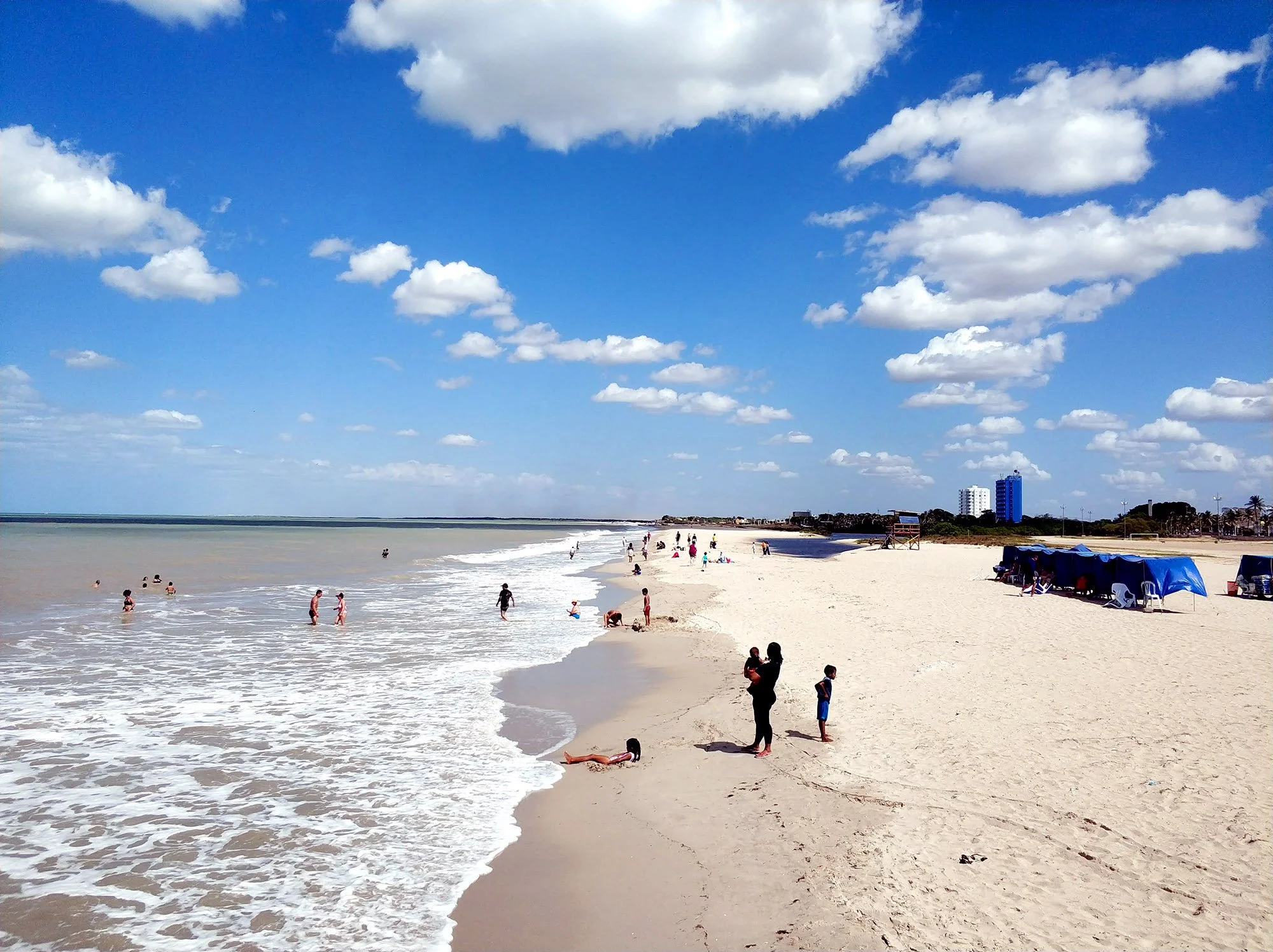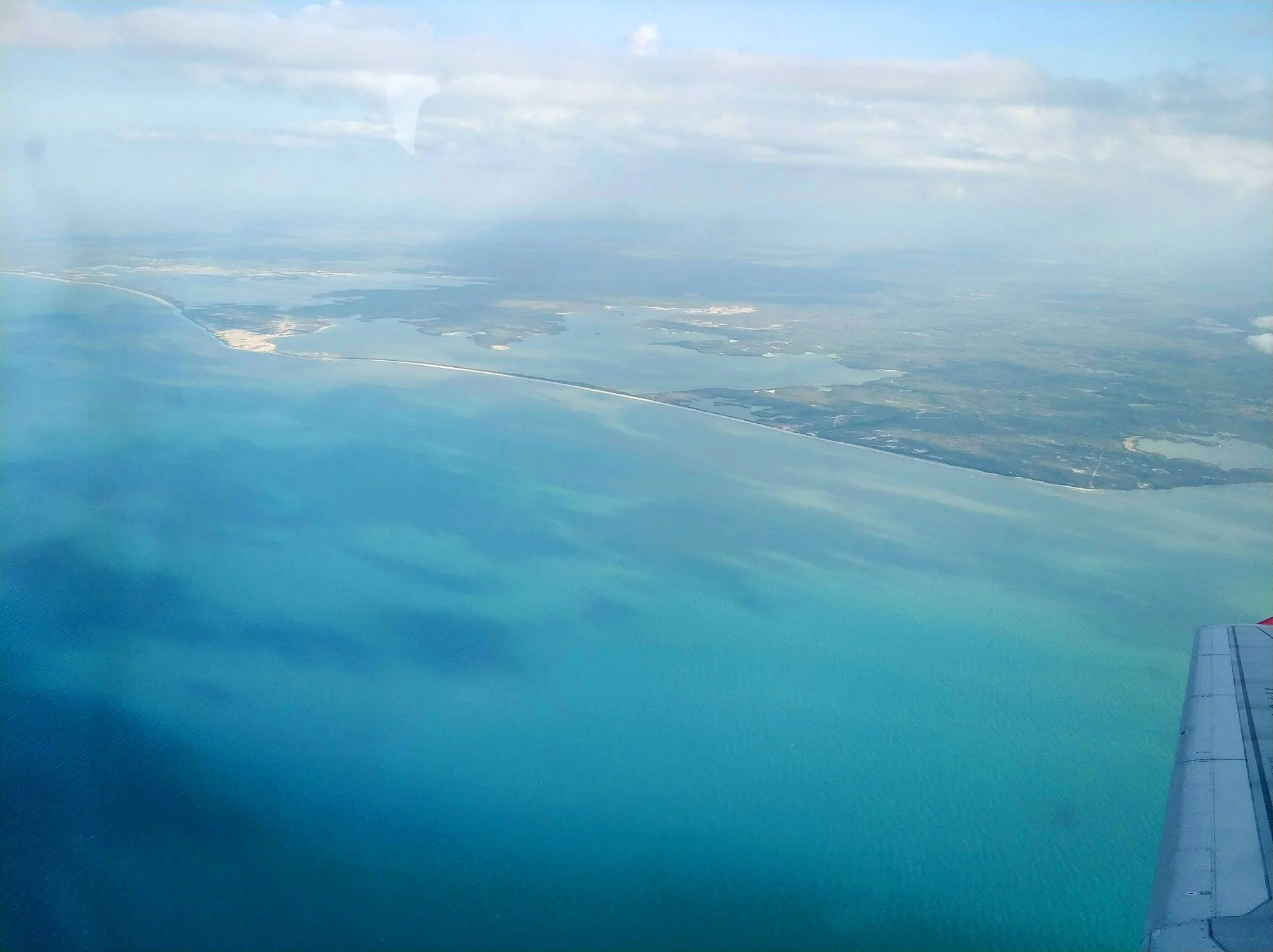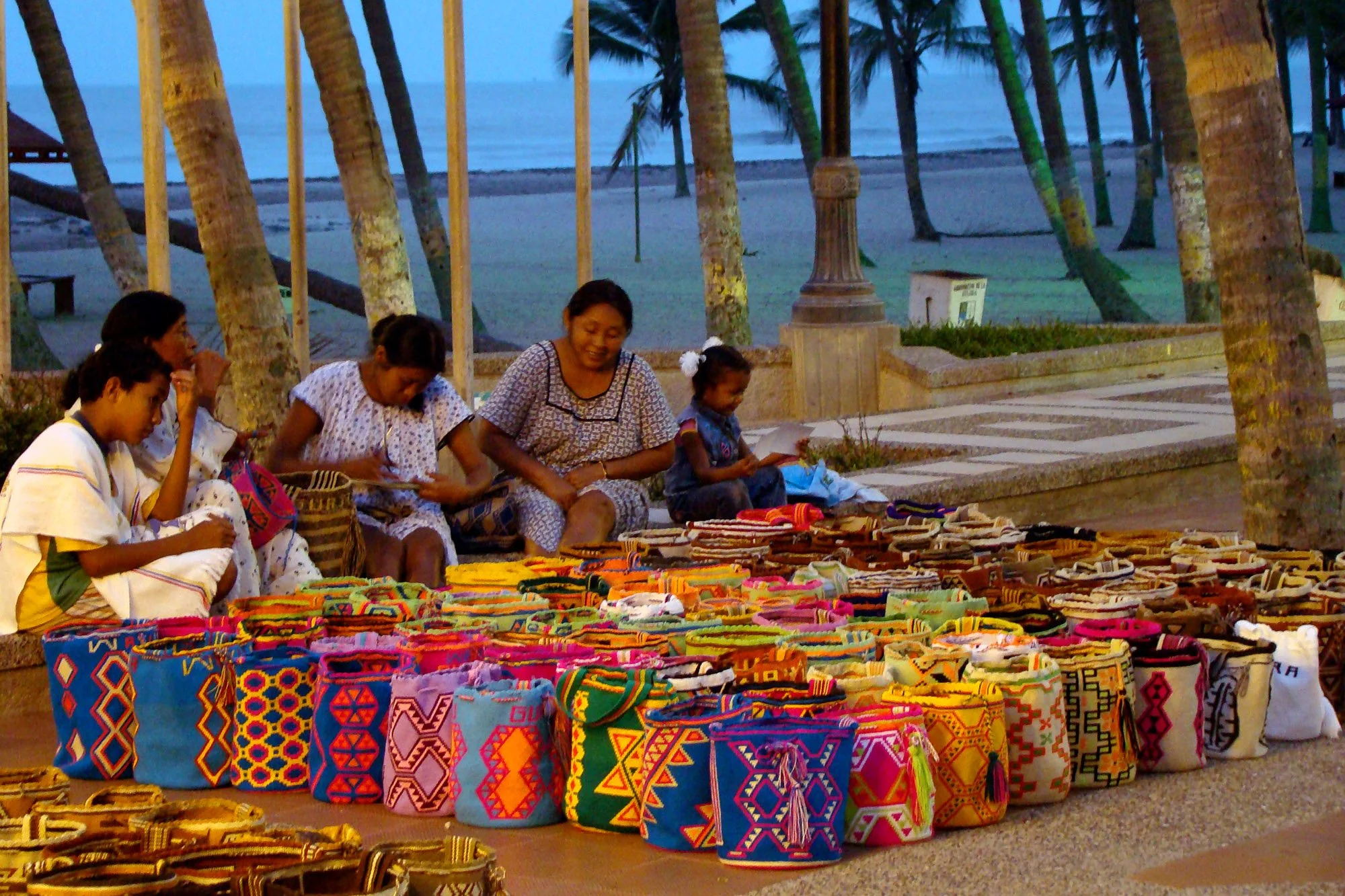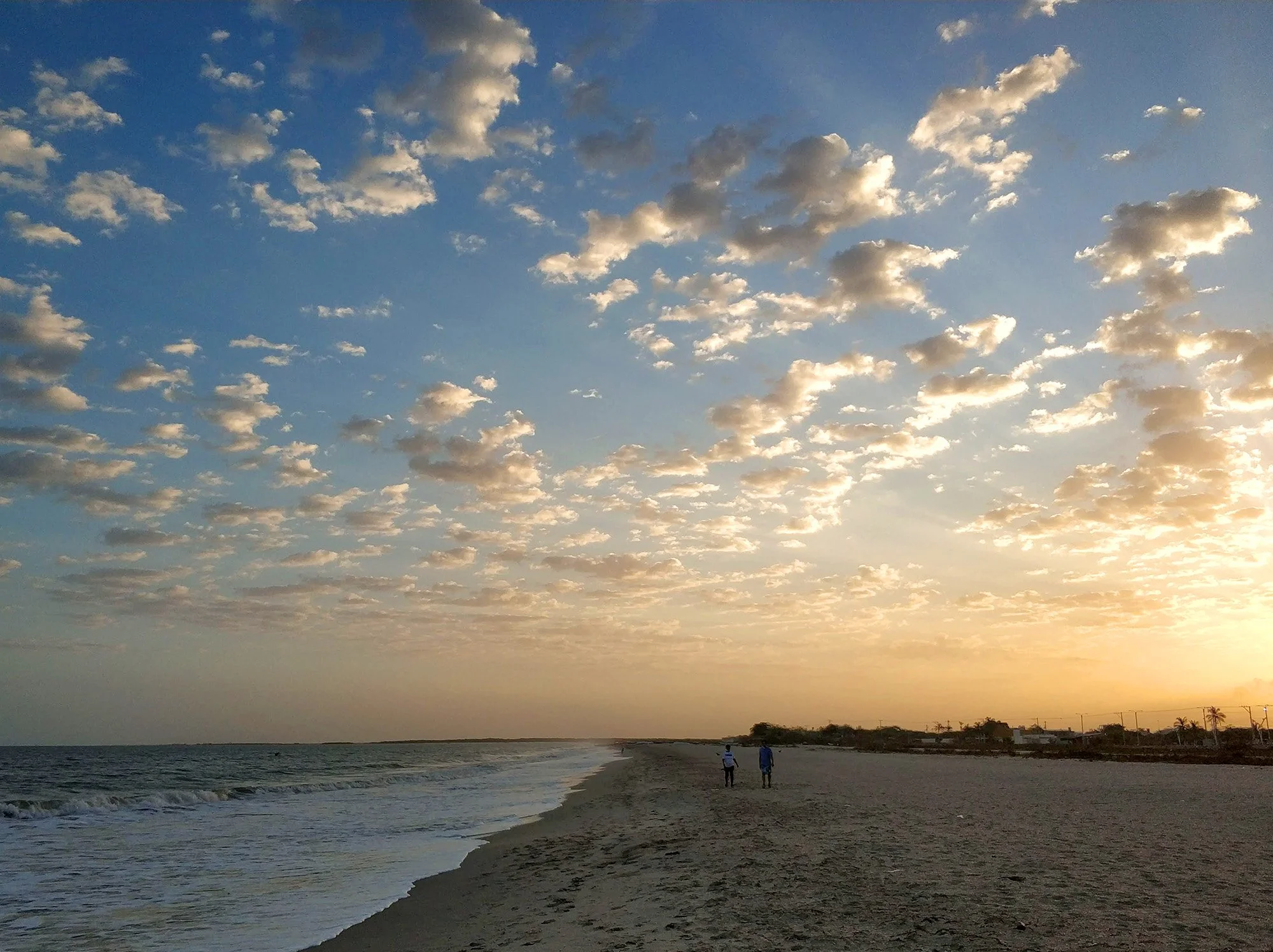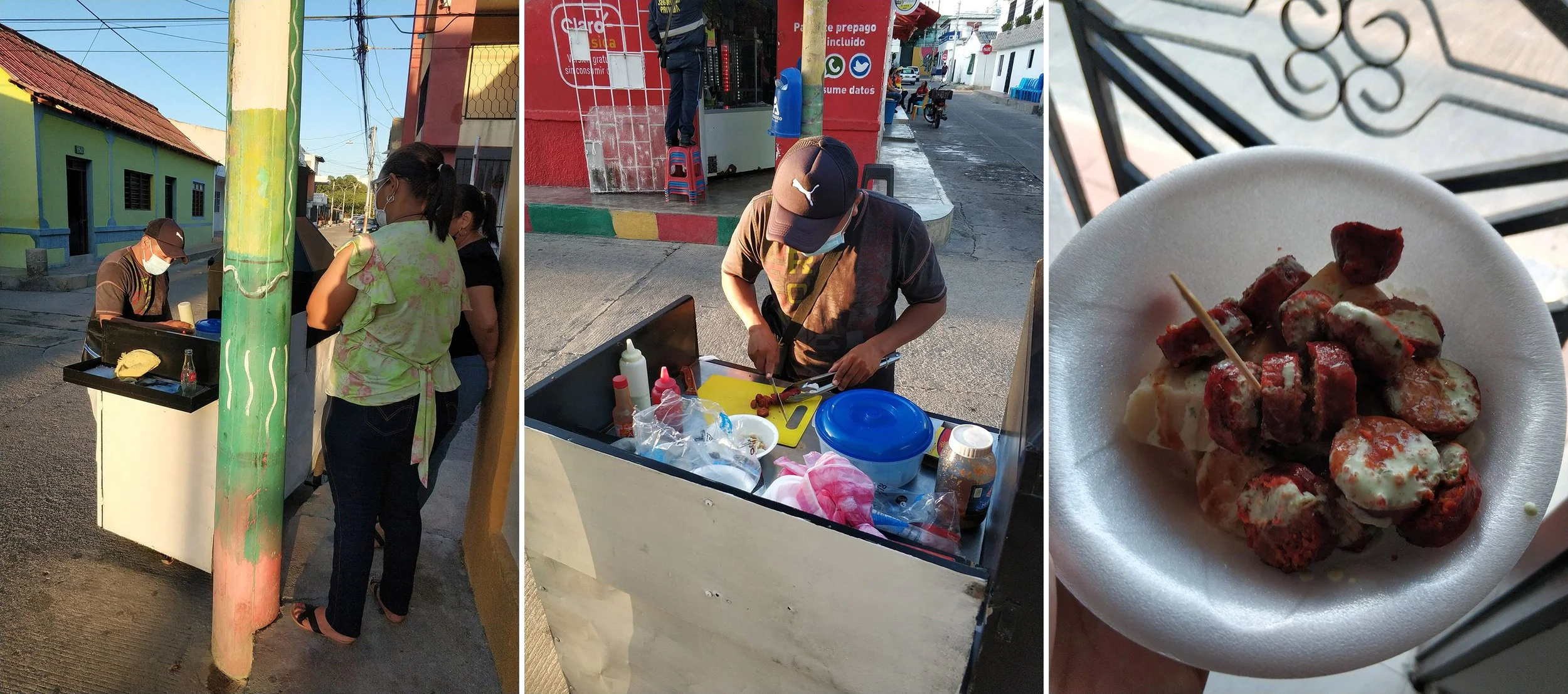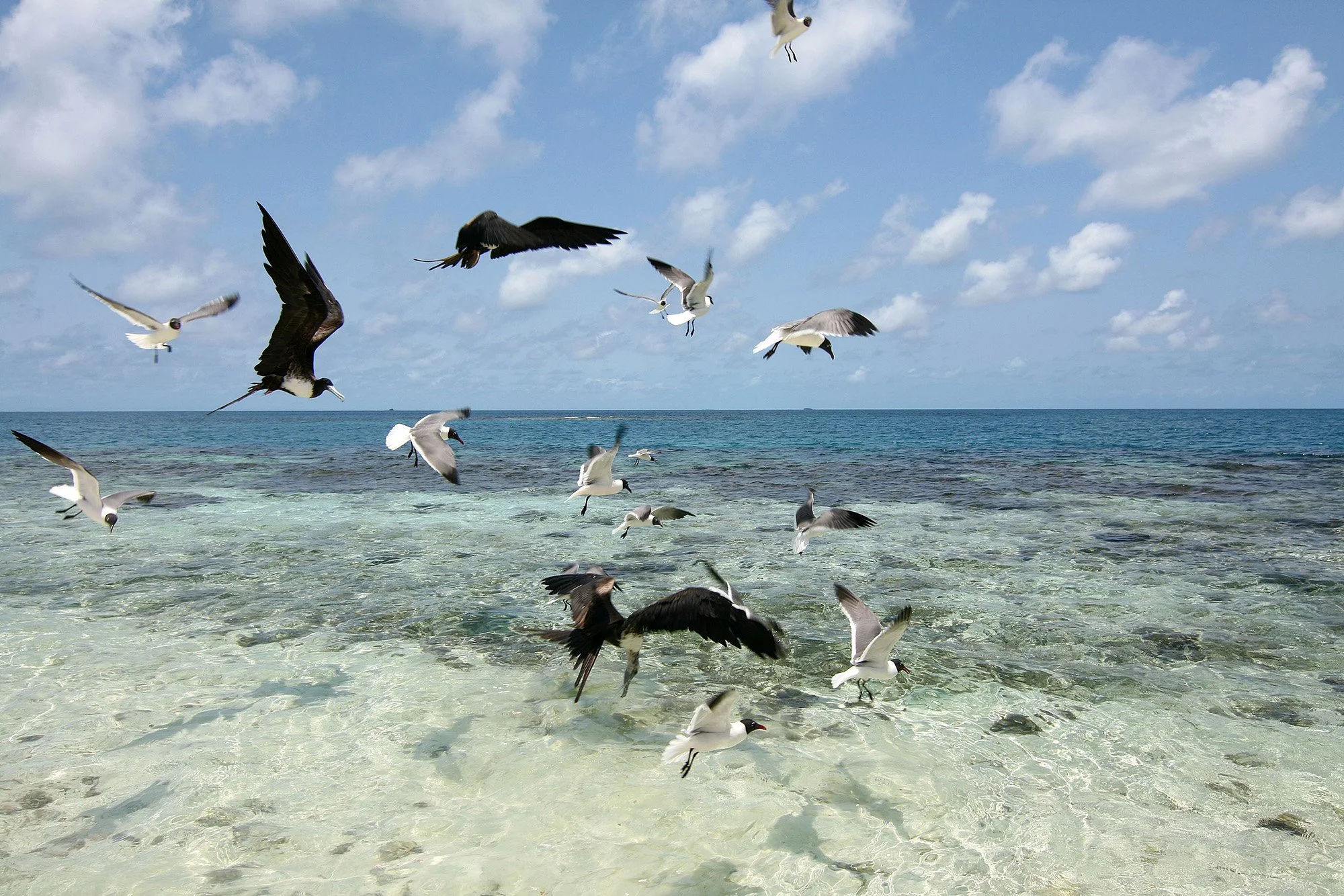22 Reasons to Never Leave Riohacha in 2022
Sure, this article probably could have just consisted entirely of this photo and the information that it's the most crowded part of a 5km beach on the busiest day of the week, and left the argument there. But then we wouldn't have needed to write the 4000 or so words you're going to find below, and we've got heaps of free time these days, so it's better to spend it in semi-productive pursuits instead of just binge drinking augardiente © TravellingCurmudgeon.com
When we arrived in Bogotá on 30 November, we'd only planned to stay a few days in the much-maligned capital before decamping to more highly praised destinations. Those 'few days' ended up turning into exactly seven weeks, and we only eventually left when forced to by the arrival of another occupant for our room. Stop numero dos in Colombia was the town of Riohacha in the Guajira district, which was recommended by literally nobody, other than perhaps Anthony Bourdain on an episode of his TV show back in 2013, but even he wasn't overly effusive about it.
We'd only planned to stay a few days in Riohacha as well, before slowly making our way westward along the Caribbean coast - Palomino, Tayrona National Park, Santa Marta, Barranquilla and Cartagena were all waiting - and our first impression of the place made the prospect of spending even a few days quite daunting. A remote, dodgy, lawless shithole indeed. Of course it took all of 24 hours for us to extend our booking for a full month, and as we post this on our one-month anniversary, we're already getting a bit wistful about having to leave - which now won't be till at least mid-March, as we couldn't help paying rent for a second month.
We considered travelling to at least a dozen places after Bogotá, but when we ran them by locals the opinion was always mixed, without exception, except for one: Riohacha, which literally no one recommended visiting or even seemed to have a nice thing to say about. So what's so great about this dusty desert town in the middle of nowhere? We're glad you asked, because we've got 22 great reasons to never leave once you've managed to make it here. From the arriving flight path, friendly locals, food carts, fruit vendors, fresh seafood and fair prices to the fishermen, flying fauna, graffiti, frequently festive atmosphere and fist-bumping police, there's lots to love, and those are just the 11 we could shoehorn into our unhealthy obsession with alliteration.
If you want a good first impression of a place, getting a free panoramic flight of its Caribbean coastline on arrival is a decent way to start © TravellingCurmudgeon.com
#1 The Landing Approach Takes You on a Scenic Flight of the Coast
After what turned out to be much ado about nothing when Avianca tried to swindle us out of the window seat we'd already paid for, there was of course almost nothing to see on the shorter than expected flight from Bogotá's gloriously efficient El Dorado Airport to Riohacha, aside from the usual billowing clouds shaped like animals and dragons. That is until we approached the Caribbean coast, hung a hard right and took in a panoramic descent over turquoise waters, sandy beaches and flamingo lagoons. Just a wonderful way to arrive somewhere, especially after an extended stay in generally chilly Bogotá. Definitely recommend booking a window seat on the right side of the plane on your next flight.
#2 Everyone Calls You Amigo
Virtually no one here speaks English, but you don't need to entiendes mucho español to appreciate the fact that almost everyone you interact with calls you 'amigo'. This is just the first of several items on this list that are all related to Riohacha feeling like one big homey, communal place, where everyone knows everyone and is friendly and laid back.
The girl working in this small village shop just off the beach definitely called us ‘Amigo' when we dropped by to grab a few beers on our first sunset beach stroll © TravellingCurmudgeon.com
#3 Wayuu People & Culture
The Wayuu make up almost half the population of the La Guajira region (or technically 'department' in Colombian bureaucratic vernacular), and to a large extend have managed to preserve their traditional way of life throughout the centuries. [We almost said "centuries of European colonial exploitation and occupation, followed by centuries of central government corruption and mismanagement", but we once caused a whole hullabaloo for using the word 'occupation' with regards to some shenanigans in the former Yugoslavia in the 1990s, and would rather not have a repeat of that while we're still a guest in the incomparably wonderful and not at all corrupt or mismanaged nation of Colombia]. In any event, the Wayuu seem like some incredibly fine people - happy, proud, hardworking, etc - and in our book the more mixed cultures a place has the better it is. Now we're going to shirk any further responsibility and just aim you in the direction of that old stalwart Wikipedia if you'd like some additional info on the subject.
If you want to purchase a brightly coloured traditional handmade bag, there's literally no better place in the entire world than along the malecón in Riohacha. Although if you don't want to purchase said bag or other similar local Wayuu crafts, then you might get annoyed that half the waterfront promenade's real estate is taken up by these pop up shops at all hours.
#4 An Ideal Climate
It might be a bit too humid for some people's comfort, but when it's 33°C every day, a balmy 24°C every night, and there's a strong sea breeze keeping you cool it's really hard to complain. And it's all rounded out with sunny blue skies and perfectly photogenic fluffy white clouds almost every day too, although It should be noted that January - March see almost zero rain historically, while May - November can get quite wet. [It should also be noted that we drafted this article on the first floor of a house with nice big terraces, and never even considered turning on the AC, and now we're finalising it on the ground floor of the same house, sitting a few centimetres from a fan yet still feeling like we're in one of those Native American sweat lodges. Point being, when you come to Riohacha, find a nice place with a big breezy terrace, and don't ever leave it.]
#5 Sunrise Swimming
It admittedly took us a full week to realise this, but probably the very best thing about Riohacha is getting up at sunrise and going for a swim, as it's the only time of day the water is pleasantly calm. Not to mention the fact that you get to watch the sun come up over a glorious landscape while you're floating in the sea.
Call us old-fashioned, but there aren't many better ways to start the day than a 6am sunrise swim in the Caribbean © TravellingCurmudgeon.com
#6 Street Food
While we're not officially connoisseurs of Colombian street food (even after seven weeks in Bogotá eating almost exclusively street food), we've got no problem declaring that Riohacha has the very best street food in the entire country. Or at minimum, it's #2 after Bogotá (ie the only other place we've been). In all seriousness though, the empanadas here are diverse, delicious and cheap. In the evenings there are pop-up stalls all over town (for our money, the one opposite the cemetery is best of the bunch), while a few bakeries offer specialty varieties using traditional Wayuu dishes like chivo asado (roasted goat) and friche (goat offal) for filling. Then there are the ladies near the fish market who fry up traditional arepas de huevo stuffed full of shrimps in the morning. Mmmm mmmm. And that's only the empanadas.
For a real Colombian street food smörgåsbord, head to Carrera 7A opposite Mercado Viejo, where you'll find several stalls slanging heavily garnished chorizo accompanied by all you can drink juice, Riohacha's legendary salchipapas (french fries topped with between 10-100 different things) and at least two carts with more varieties of fully packed mini arepas than you can hope to taste in one sitting. Meanwhile for seafood (ceviche, shrimp cocktail, etc) and fresh juices, there are about a dozen brightly painted little huts down on the waterfront that do brisk business throughout the day. We could actually ramble on for a while longer (listing various other meat on sticks, grilled hot dogs and a variety of other seafood), but we've already made ourselves hungry.....
This definitely isn't the most representative scene of Riohacha's street food, but it was a 30-second walk from our apartment, and we made a chorizo run just before overtime of the Chiefs historic choke job against the Bengals, which may or may not have cost us significant dinero and forced us to imbibe significant cerveza (we'd never take photos of food vendors we frequent whilst sober).....
#7 Monuments
There isn't a ton of public art here (unless you count murals for candidates in the upcoming elections), but what they do have is concentrated in the more ‘touristy’ parts of town near the beach. We'll get to the graffiti separately below, but first up a handful of monuments that are quite spectacular in their own ways. Here are the four we found most impressive:
#7a Monumento La Identidad
The obvious one to start with is the Monumento La Identidad (Monument of Identity) right in the middle of the malecón (although until a few days ago on Google Maps it was half a kilometre away - you're welcome Riohacha), which depicts the diverse cast of characters (some real individuals, some representative) who have played a role in Guajira's history.
#7b Palabrero
Just a bit further down the malecón there's the shiny copper-coloured Palabrero, which on first glance one might assume is some local musician, but is actually a depiction of a Wayuu tradition for mediation. Or more specifically, according to our friends at Wikipedia: "A pütchipü'ü, or pütche'ejachi (in Wayuu, "messenger of the word"; Spanish: palabrero), is the central element in the traditional administration justice system of the Wayuu people. The role of a pütchipü'ü is to solve conflicts through mediation and negotiation." Good stuff!
#7c Monumento a Los Embarradores
Around the corner, down Carrera 1, passed the dusty football stadium that's currently labelled on Google Maps as La Cagadero (‘The Shithole’), you'll come to a statue with two men who appear to be wearing paper bags over their heads. While we first assumed this was to commemorate some tragic kidnapping (or perhaps ashamed sports fans), it luckily turns out to be the depiction of Los Embarradores, a carnival tradition going back more than 150 years, where people lather themselves up with mud in order to commemorate the muddy banks of the river where boats used to embark on their journeys out to sea.
#7d Francisco El Hombre
And last, but certainly not least, we've got Francisco El Hombre, which can be found in city's main roundabout. Despite what it looks like, it's actually showing Francisco the Man (great name!) out-duelling the Devil on his accordion. The legend may or may not be true (it's 2022, so who's to really say anymore), but either way was (likely) based on a real person who was from the Guajira region, and they've got an annual accordion festival to prove it.
#8 Fishermen
There's some 5km of wide, white, sandy beach stretching east from Riohacha, but if you get more than 100m from the main pier in the centre of town, you'll mostly only be sharing it with local fishermen. Pass by in the mornings or late afternoons and the rustic wooden boats with colourfully painted names on the sides will either be heading out to fish or coming back with the day's catch, with much fanfare on either occasion - younger guys carrying huge canisters (of presumably practically free Venezuelan petrol) on sticks or wheeling engines laying on tyres in carts, groups of men schlepping the boats out of or into the water, and children and women folk greeting them or going for a swim. It's all quite a sight to behold. And if you really want some National Geographic scenes, you can keep on walking till you get to the estuary even further down the shore, where you can often see individuals fishing by throwing nets into the murky river waters, then pulling them up by hand.
#9 Mobile Fruit and Veg Sellers
We're honestly not the biggest fan of that universally praised, end all and be all of Latin American literature, Nobel laureate Gabriel García Márquez's 100 Years of Solitude. Don't get us wrong, it starts out fine, but by the mid-point it feels like you've been reading it for 100 years, and you just wanted it to finish. But since worldwide critical and public opinion can't possibly be wrong, when it comes to the late Gabo's masterpiece, we think the problem probably lies in the fact that something almost always gets lost in the translation.
Anyway, what does all that have to do with old dudes pushing equally old wooden carts laden with fruit and veg up and down the dusty streets of Riohacha? If you have to ask that question, then you've likely never read the book. Because as tedious as we found the tome, hearing raspy voices shout out 'papaya, pomelo, naranja, piña, mandarina, banana, aguacate, tomate, yuca, papa, platano' almost nonstop for several hours every morning not only helps you improve your Spanish vocabulary, but also transports you to the fictional town of Macondo.
#10 Graffiti
While there's obviously not nearly as much graffiti in Riohacha as in Bogotá (aka one of the world's foremost graffiti and street art cities), there are enough surprises around random corners to keep amateur graffiti spotters honest. We also generally aren't huge fans of commissioned murals, especially when they're the community oriented, rah-rah type, but there are some incredible ones of the latter variety on here, many depicting different aspects of Wayuu history and culture with elements borrowing from Kahloe, Dalí and Chirico, amongst others. Really cool stuff!
This is an awesome one, which is lucky for us, because it's almost literally just outside our door so we see it all the time. Check out more of the artist's work on Instagram @beje_art © TravellingCurmudgeon.com
#11 Loads of Exotic Birds
We're not now, nor have we ever been, a member of the Audubon society, but birds are objectively fucking awesome, especially when they're exotic Caribbean birds doing exotic Caribbean stuff while you're walking along the beach or frolicking in the water (that's right, even curmudgeons enjoy a good frolic from time to time). Aside from the storks and gulls, we had no idea what any of the birds pictured below were called before coming to Riohacha, but now have a certain affection for each and every species (even the evil looking turkey vultures that aren't pictured).
The pelicans are obviously the best of the lot (even though we thought they were storks the first few weeks here), as they fly parallel to the coast in pods (or pouches, scoops, squadrons or fleets - seems zoologists are even more indecisive than we are) of eight or nine, hovering just over the water. Frigatebirds come a close second, because they look the coolest - before we knew their name we described them as a cross between a giant bat, a seagull and B-2 stealth bomber. Anhinga are entertaining enough because they dive under the water, but what really put them over the top is the fact that their name is taken from an indigenous Brazilian language and means ‘snake bird' or ‘devil bird’. The yellow-headed caracara are like hawks with more colourful beaks and a bad toupée, while the great-tailed grackles do indeed have great tails, and are the closest thing Riohacha has to crows or ravens (our favourite animals), despite not being related to them at all. And rounding out the selection are snowy egrets - some of which range in shade from orange to neon pink - and the great kiskadee, which seem to hang out in and around the city itself, so are like the sexier, Caribbean version of sparrows.
#12 Socialising in the Streets
It seems most evenings, but especially at the weekends, you can't walk down any random residential neighbourhood for more than a few minutes without coming across a family or group of friends hanging out in the street, sitting around a table on plastic chairs, enjoying a bit of breeze and fresh air, with some kind of Latin music filling the street. The most entertaining of these are the groups of men drinking beer or aguardiente (or both) and often playing either dominoes or cards. If we weren't having a dry February, we'd surely have invited ourself to join them by now, as it would be a great way to improve one's Spanish.
#13 Cheap Fresh Seafood
Our meals are still mostly comprised of empanadas, arepas and chorizo (because they're tasty and insanely cheap), or cooking at home (solely for the enjoyment of cooking itself), but we still appreciate just knowing that there's all this fresh and relatively cheap seafood out there for others to enjoy on a regular basis.
#14 Colonial Architecture in the Tropics
Colonialism was irredeemably terrible, and loads of the world's most pressing problems in 2022 can still be directly traced back to the countless atrocities committed by the various colonial powers. But god damn it if a centuries-old Spanish style church, monastery or villa doesn't just look cool sitting in the tropics surrounded by palm trees.
The old Capuchin Monastery (left) sadly seems to be monkless these days, but the Divina Pastora Chapel (right) still has frequent services, with attendance that would make most European churches jealous (or at least it would if envy weren't one of those especially frowned upon sins we learned about from David Fincher's 1990s cult classic SE7EN) © TravellingCurmudgeon.com
#15 No Inflated Prices or Gringo Tax
This is true both in terms of not getting gouged by the usual inflated resort town prices in shops, or getting overcharged because it's blatantly obvious that you're a foreigner. The prices in shops are the same as Bogotá, but even more reassuringly the aforementioned street food vendors and fruit and veg cart folks always seem to give you the local price, whether you're buying some empanadas from some random pop up stall or a papaya from your doorstep. For the fruit and veg the prices can change daily depending on the quality - an avocado can cost $2000 or $4000, and the latter we were sceptical about, but it made the best guacamole we've ever eaten (including in restaurants). Same with papayas. The normal price is $2000 for regular size, or $3000 for the bigger ones, while our local dealer will give us the smaller ones for $1500 (which in real money is €0.44, €0.67 and €0.33 respectively). And don't get us started on the piñas, aka pineapples, a giant one will only set you back $3000, and not only tastes delicious, but also serves as decoration for the flat for a day or two before it gets eaten.
Is it possible for us to hear the word 'papaya', without subconsciously thinking of this scene from Seinfeld, even if the person saying it is a raspy old fruit cart vendor with a thick Colombian accent? No, no it's not…..
#16 Open Doors
It's hot and humid here, so quite common for the houses in the city centre to be constructed so that the living rooms are facing out to the streets and the doors are almost always open to let in the breeze. Now this isn't to say that we're walking around peering into people's private spaces in some kind of perverted, voyeuristic, lecherous way, just that it gives this the same kind of homey, communal, 'wow, this is what it feels like to live in a civilised, open society' that you get in places like Scandinavia and the Netherlands.
UPDATE I: We liked this concept much more in the abstract, which is to say before moving from a bright, airy first floor room in an Airbnb to a dark, stuffy one-bedroom ground floor apartment, where it's necessary to keep the door and windows open onto a street with loads of foot traffic....
UPDATE II: After a few more days of feeling like a captive in a Gringo Zoo, we're now fully comfortable living on the ground floor, keeping the door open and only sometimes wearing a shirt. You feel much more a part of the local neighbourhood when you're down here at street level, rather than way up in your first floor ivory tower....
Yes, we did purposely wait a few extra seconds for whatever it was that was approaching in order to take a shot while it passed. But the fact that its decals exactly match the colour-scheme of the two brand new political murals on the wall in the background was just the universe giving us a another free hit of that pure, uncut Colombian coincidence, since it knows how much we love it.... © TravellingCurmudgeon.com
#17 Stray Dogs
This might seem a negative, and for some people it might actually be, but as someone who's generally not a fan of stray dogs on account of some rather unpleasant experiences,* we've got to say that they really liven the place up. First of all, they're almost all similar looking, medium-sized and have those dog faces that always look like they're smiling. And if seeing a smiling dog trotting merrily along a beach or through an old square doesn't bring a smile to your own face, then there's obviously a hole of not insignificant size in your soul. And second, they always seem to be up to something - like fucking on the crowded malecón, dropping a deuce in the sand next to a bunch of children who run away screaming (with delight), emerging from underneath an overturned boat in the middle of the day to chase after a pack of goats that are passing by or just laying in the sun upside down giving you an adorable sink eye as you pass by.
UPDATE: Literally six days after posting this article, we got bit by a dog for the first time in our life, so this item on the list is currently undergoing a thorough and vigorous editorial review in order to decide what do with it. More info soon….
*If we limited ourselves to just three examples, for brevity's sake, we'd have to go with: 1) That time we had to choose between running through a landmine field and getting attacked by a whole pack of war-weary canines just outside of Kabul, Afghanistan, 2) That time we were riding a bicycle around the airport on the island of Djerba off the coast of Tunisia and had another pack of stray dogs chase us at the exact moment we got a flat tyre, and 3) That time we were walking around Ohrid, Macedonia on Easter, and already felt uncomfortable because everyone in town was out for a stroll dressed in their Sunday best and we were dressed like a filthy hobo, only to have some little yippy dog follow us barking and drawing literally everyone's attention to us for what seemed like hours but was likely only a few minutes.
This song pops into our head 90-95% of the time whenever we see three or four dogs trotting along together, and 100% of the time if we see five or more, which is not an infrequent sight here, especially on the beach and beach road to the east of the city centre in the late afternoon.
#18 Police
Outside of actual riots, protests and the like, we can't remember ever having seen more police per square metre than in Riohacha - and they're super easy to spot, because the only ones with bright neon green vests on. On the one hand, this should make you ask yourself 'Wow, how dangerous is this place that it needs pairs of armed police literally every 20 metres?', but what's the point in trifling yourself with hypothetical questions, when you can just look on the bright side. The bright side being that they're generally super friendly, and never seem to hassle anyone. Based on what we saw in Bogotá - the types of experiences that makes people write All Cats Are Beautiful on walls - when we saw pairs of police standing by various street food stall vendors here, our assumption was they were getting hassled about permits or Covid measures by assholes abusing their power, but we soon realised that in Riohacha the police are just really hungry and/or thirsty most of the day. Meanwhile, the ones stationed in the shade are either on their phones or laughing about something funny their partner just told them. And if you're the only foreigner in town who walks around all the time, then some of them will call you over when they seeing you passing just to give you a fist bump (no joke).
#19 Colourful (and Loud) Political Campaigns
Congressional elections are coming up in March, and as far as we can tell campaigning in Riohacha primarily consists of painting brightly coloured murals all over the place and driving around in huge SUVs with giant speakers strapped to the roof blasting catchy pop music that may or may not slip the candidates name into the lyrics. It's absurd and over the top, and we love it. No comment on the actual parties, candidates or Colombian politics in general though (although Deluque has by far the catchiest theme song of the all the ones we've heard - it's seriously been stuck in our head for days as we write this).
We've got no idea who either candidate is, but we enjoyed watching this mural go up over a few days just outside our front door, and the bright colours have really freshened up what was previously a much of the white sameness stretch of street © TravellingCurmudgeon.com
#20 Live Bands & Music in the Streets
Can't say for sure how common this is, but we've seen live bands in the streets at least four times in our first in two weeks here - twice for random business openings and twice for political rallies (see previous reason). Luckily, one of those times we had had enough beers to not feel awkward standing in the middle of the road taking video of it (see below). Although unfortunately for that particular shop, whomever arranged the opening celebration apparently hadn't done their homework when it came to the South American World Cup qualifying schedule, because they were competing against the Colombia-Peru match, which meant that foot traffic at that particular time was at pretty much an all-time low. And in addition to the odd live bad, there's pretty much music blasting within earshot from at least one set of speakers, no matter where you are in the city. Sometimes this is from bars or shops, but often just from random houses or even more often cars. It can get a bit loud, but the benefit of having a nonstop festive atmosphere outweighs the long-term hearing loss.
#21 Almost No Mosquitos
Some places really get your travel juices flowing, seeming absolutely too good to be true - mostly ‘idyllic beaches with crystal clear water surrounded by jungle’ type places. Then you get there and find out that it was too good to be true, because there are swarms of mosquitos everywhere. This absurd article that Travel + Leisure continuously posts on their social media is a great example of what we're talking about. None of that in Riohacha though. In more than two weeks here, we've only been bitten a few times, and the itching went away quite quickly. Of course that didn't stop us swearing out loud and trying to smash the fuckers in the bathroom, which we managed to do on several occasions. But even this is a positive, because then you get to feel exactly like those cunty bastards who pose with the big game they've shot, only without the immorality, well-deserved public scorn or super expensive trip to Africa.
#22 Its Terrible Reputation
Which is really just to say that there aren't many crowds, the vast majority of tourists who come here are Colombian, and almost everyone who visits either just stays for a short weekend break from one of the country's larger cities, or stops over for a night or at most two on their way to or from Cabo de la Vela and Punta Gallinas further down the coast. We considered travelling to at least a dozen places after Bogotá, but when we ran them by locals the opinion was always mixed, without exception, except for one: Riohacha, which literally no one recommended visiting or even had a nice thing to say about. Why does it have such a bad reputation? We're the worst person to ask, since we obviously love the place....
